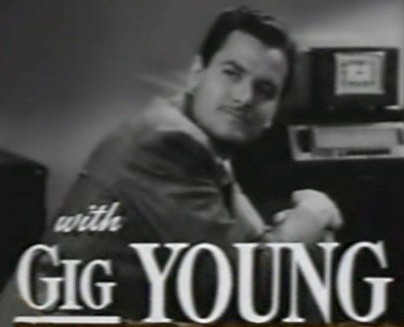Early life and career
Born Byron
Elsworth Barr in St. Cloud, Minnesota, his parents John and Emma
Barr raised him in Washington DC. He developed a passion for the
theatre while appearing in high school plays, then after some
amateur experience, he applied for and received a scholarship to
the acclaimed Pasadena Community Playhouse.
While
acting in 'Pancho', a south-of-the-border play by Lowell
Barrington, he and the leading actor in the play, George Reeves,
were spotted by a Warner Brothers talent scout. Both actors were
signed to supporting player contracts with the studio. A myth
has developed that Young changed his given name Byron Barr to
avoid confusion with another actor of the same name.
Actually,
the name "Gig Young" was taken from a character he played in one
of his earliest films, The Gay Sisters (1942). The other Byron
Barr did not make his film debut until Double Indemnity in 1944,
two years after Young took his screen name.
Signed to a
contract with Warner Brothers, Young appeared in supporting
roles in numerous films during the 1940s, and came to be
regarded as a popular and likeable second lead, playing the
brothers or friends of the principal characters. During World
War II, Young took a hiatus from his movie career and served
admirably in the United States Coast Guard, alongside fellow
Hollywood actors Cesar Romero and Richard Cromwell.
In the
early 1950s Young began to play the type of role that he would
become best known for, a sardonic but engaging and affable
drunk. His dramatic work as an alcoholic in Come Fill the Cup
(1951), and his comedic role as a tipsy but ultimately charming
cad in Teacher's Pet (1958), each earned him nominations for an
Academy Award for Best Supporting Actor.
Success
and decline
Gig Young
was the host of Warner Bros. Presents, an umbrella title for
three television series (Casablanca, Kings Row, and Cheyenne)
that aired during the 1955-56 season on ABC Television. This
show ushered the entry of the Warner Bros. Studio into
television production, just as Disneyland (the TV show) had done
for the Walt Disney Studios a year earlier also on ABC.
He won the
Academy Award for his role as Rocky, the dance marathon emcee
and promoter in They Shoot Horses, Don't They? (1969). Young is
considered the ultimate victim of the Oscar curse, so-called
because many Academy Award winners have seen their careers
decline or reach a dead-end after winning the ultimate accolade
from their peers.
According
to his fourth wife, Elaine , "What he was aching for, as he
walked up to collect his Oscar, was a role in his own movie --
one that they could finally call a Gig Young movie."
Young was
shattered when that opportunity did not materialise. "For Gig,
the Oscar was literally the kiss of death, the end of the line,"
according to Williams. He himself said to Louella Parsons after
failing to win in 1951 that "So many people who have been
nominated for an Oscar have had bad luck afterwards."
Alcoholism
plagued his later years. Cast in Blazing Saddles (1974) as the
Waco Kid, he was replaced by director Mel Brooks with Gene
Wilder on the first day of filming because he was suffering from
delirium tremens on the set.
Personal
life and death
Young
married his third wife, actress Elizabeth Montgomery, 20 years
his junior, on 28 December 1956. They divorced in January 1963
amid rumors of domestic violence.
Young's
fourth wife, Elaine Young née Williams, (married in October
1963) became a prominent Beverly Hills real estate agent in the
1970s and she brokered many transactions over the ensuing years
to myriad Hollywood luminaries. Elaine Young, who died in April
2006, was also noted for overcoming disfiguring plastic surgery
and for her outspoken crusade for reforms against improperly
trained cosmetic surgeons.
On 27
September 1978, aged 64, he married his fifth wife, a 31
year-old German art gallery employee named Kim Schmidt. On 19
October 1978, three weeks after their marriage, they were both
found dead at home with gunshot wounds to the head in their New
York City apartment. Police theorize that Young first shot his
wife and then turned the gun on himself in a suicide pact.
The
murder/suicide occurred at The Osborne Apartments on West 57th
Street between Seventh Avenue & Broadway, a co-op building. On
the day he died, Gig Young taped an episode of the Joe Franklin
TV show (which never aired) and then went home and committed the
murder suicide.
His will,
which covered a $200,000 estate, left his Academy Award to his
agent, Martin Baum, and Baum's wife. The wording of the will
called it "the Oscar that I won because of Martin's help." New
York City police found the statuette beside the bodies of Young
and his wife.
He had one
daughter Jennifer Young (b. 21 April 1964); he filed a
non-paternity suit claiming he wasn't her father and left her
$10 in his will.

